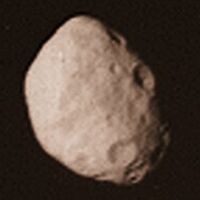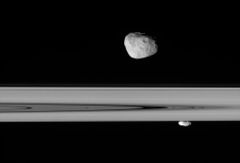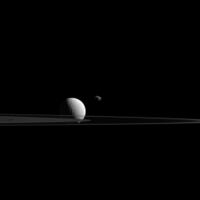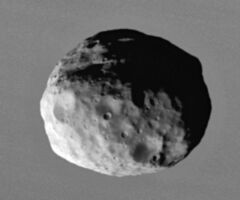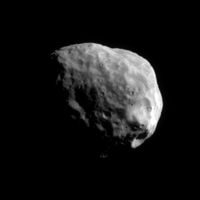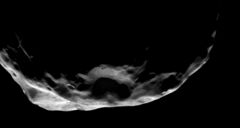جانوس (قمر)
 Janus, as imaged by Cassini before Saturn in 2006 | |
| الاكتشاف | |
|---|---|
| اكتشفه | أودوان دولفوس |
| تاريخ الاكتشاف | 15 ديسمبر 1966 |
| التسميات | |
| الصفات | Janian |
| السمات المدارية[1] | |
| حقبة December 31, 2003 (JD 2 453 005.5) | |
| 151 460 ± 10 km | |
| Eccentricity | 0.0068 |
| 0.694 660 342 d | |
| Inclination | 0.163 ± 0.004° to Saturn's equator |
| Satellite of | زحل |
| السمات الطبيعية | |
| الأبعاد | 193×173×137 km [2] |
نصف القطر المتوسط | 89.4 ± 3.0 [2] |
Mean radius | 89.4 ± 3.0 [2] |
| Mass | 1.912 ± 0.005 ×1018 kg [1] |
Mean density | 0.64 ± 0.06 g/cm³[2] |
| ~0.0137 m/s2 | |
| synchronous | |
| zero | |
| Albedo | 0.71 ± 0.02 (geometric)[3] |
جانوس Janus هو أحد الأقمار الداخلية لكوكب زحل. يُعرف أيضاً بإسم "زحل 10" أو "Saturn X". وهو مسمى على اسم الكائن الأسطوري جانوس.
التاريخ
اكتشفه الفلكي أودوان دولفوس في 15 ديسمبر 1966، وأطلق عليه الاسم المؤقت S/1966 S 2. Previously, Jean Texereau had photographed Janus on 29 October 1966 without realising it. On 18 December, Richard Walker observed an object in the same orbit as Janus, but whose position could not be reconciled with the previous observations. Twelve years later, in October 1978, Stephen M. Larson and John W. Fountain realised that the 1966 observations were best explained by two distinct objects (Janus and Epimetheus) sharing very similar orbits,[4] Walker is now credited with the discovery of Epimetheus.[5] Voyager 1 confirmed this orbital configuration in 1980.[6] (See co-orbital moon for a more detailed description of their unique arrangement.)
تاريخ الرصد
Janus was observed on subsequent occasions and given different provisional designations. Pioneer 11's three energetic-particle detectors detected its "shadow" when the probe flew by Saturn on 1 September 1979 (S/1979 S 2).[7] Janus was observed by Dan Pascu on 19 February 1980 (S/1980 S 1),[8] and then by John W. Fountain, Stephen M. Larson, Harold J. Reitsema and Bradford A. Smith on 23 February 1980 (S/1980 S 2).[9]
الاسم
Janus is named after the two-faced Roman god Janus. Although the name was informally proposed soon after the initial 1966 discovery,[10] it was not officially adopted until 1983,[أ] when Epimetheus was also named.
The Oxford English Dictionary lists the adjectival form of the moon's name as Janian.
المدار

ويشترك مع جانوس في مداره القمر الآخر ابيمثيوس (قمر).
السمات الطبيعية
هو قمر صغير لا يتجاوز قطره 188 كيلو كترا ومعدل مسافته عن كوكبه الأم نحو 151,500 كيلو متر.
Janus is extensively cratered with several craters larger than 30 km, but has few linear features. Janus's surface appears to be older than Prometheus's but younger than Pandora's.
Janus has a very low density and relatively high albedo, meaning that it is likely very icy and porous (a rubble pile).
سمات
Craters on Janus, like those on Epimetheus, are named after characters in the legend of Castor and Pollux.[11]
| الاسم | النطق | باليونانية |
|---|---|---|
| Castor | /ˈkæstər/ | Κάστωρ |
| Idas | /ˈaɪdəs/ | Ἴδας |
| Lynceus | /ˈlɪnsiːəs/ | Λυγκεύς |
| Phoibe (of Messenia) | /ˈfɔɪbiː/ | Φοίβη |
التفاعل مع الحلقات
A faint dust ring is present around the region occupied by the orbits of Janus and Epimetheus, as revealed by images taken in forward-scattered light by the Cassini spacecraft in 2006. The ring has a radial extent of about 5000 km.[12] Its source is particles blasted off their surfaces by meteoroid impacts, which then form a diffuse ring around their orbital paths.[13]
Along with Epimetheus, Janus acts as a shepherd moon, maintaining the sharp outer edge of the A Ring in a 7:6 orbital resonance. The effect is more obvious when the more massive Janus is on the resonant (inner) orbit.[14]
معرض الصور
Janus as viewed by Voyager 2 (1981-08-25).
Janus and Prometheus lie above and below Saturn's rings (2006-04-29).
Janus and Tethys (foreground) near Saturn's rings (2015-10-27).
Janus in front of Saturn as imaged by Cassini (2006-09-25).
Janus as imaged by Cassini (2008-02-20).
في الثقافة الشعبية
- In the book Pushing Ice by Alastair Reynolds, Janus plays a major role. At the beginning of the book, it suddenly deviates from its normal orbit and accelerates out of the solar system.
انظر أيضا
ملاحظات
- ^ Transactions of the International Astronomical Union, Vol. XVIIIA, 1982 (confirms Janus, names Epimetheus, Telesto, Calypso) (mentioned in IAUC 3872: Satellites of Jupiter and Saturn, September 30, 1983)
المصادر
- مؤمن, عبد الأمير (2006). قاموس دار العلم الفلكي. بيروت، لبنان: دار العلم للملايين.
{{cite book}}: Cite has empty unknown parameter:|طبعة أولى coauthors=(help)
- ^ أ ب Spitale, J. N.; et al. (2006). "The orbits of Saturn's small satellites derived from combined historic and Cassini imaging observations". The Astronomical Journal. 132 (2): 692–710. doi:10.1086/505206.
{{cite journal}}: Explicit use of et al. in:|author=(help) - ^ أ ب ت Porco, C. C.; et al. (2006). "Physical Characteristics and Possible Accretionary Origins for Saturn's Small Satellites" (PDF). Bulletin of the American Astronomical Society. 37: 768.
{{cite journal}}: Explicit use of et al. in:|author=(help) - ^ Verbiscer, A.; French, R.; Showalter, M.; and Helfenstein, P.; Enceladus: Cosmic Graffiti Artist Caught in the Act, Science, Vol. 315, No. 5813 (February 9, 2007), p. 815 (supporting online material, table S1)
- ^ Fountain & Larson 1978.
- ^ IAUC 1991.
- ^ Solar System, NASA: Janus.
- ^ IAUC 3417.
- ^ IAUC 3454.
- ^ IAUC 3456.
- ^ IAUC 1995.
- ^ USGS: Janus nomenclature
- ^ JPL/NASA: Moon-Made Rings.
- ^ JPL/NASA: Creating New Rings.
- ^ El Moutamid et al 2015.
ببليوگرافيا
- Fountain, J. W.; Larson, S. M. (1978). "Saturn's ring and nearby faint satellites". Icarus. 36 (1): 92–106. Bibcode:1978Icar...36...92F. doi:10.1016/0019-1035(78)90076-3.
- El Moutamid, M.; et al. (1 October 2015). "How Janus' Orbital Swap Affects the Edge of Saturn's A Ring?". Icarus. 279: 125–140. arXiv:1510.00434. Bibcode:2016Icar..279..125E. doi:10.1016/j.icarus.2015.10.025. S2CID 51785280.
- Gingerich, Owen (January 3, 1967). "Probable New Satellite of Saturn" (discovery). IAU Circular. 1987: 1. Bibcode:1967IAUC.1987....1D. Retrieved 2011-12-28.
- Gingerich, Owen (January 6, 1967). "Possible New Satellite of Saturn". IAU Circular. 1991. Retrieved 2011-12-28.
- Gingerich, Owen (February 1, 1967). "Saturn X (Janus)" (naming Janus). IAU Circular. 1995. Retrieved 2011-12-28.
- "PIA08170: The Dancing Moons". Photojournal. JPL/NASA. 2006-03-05. Retrieved 2016-01-17.
- "PIA08328: Moon-Made Rings". Photojournal. JPL/NASA. 2006-10-11. Retrieved 2011-12-29.
- "NASA Finds Saturn's Moons May Be Creating New Rings". Cassini Solstice Mission. JPL/NASA. October 11, 2006. Archived from the original on February 12, 2012. Retrieved 2011-12-29.
- Marsden, Brian G. (October 25, 1979). "New Ring and Satellites of Saturn". IAU Circular. 3417: 1. Bibcode:1979IAUC.3417....1G. Retrieved 2011-12-29.
- Marsden, Brian G. (February 25, 1980). "Saturn". IAU Circular. 3454. Retrieved 2011-12-29.
- Marsden, Brian G. (February 29, 1980). "1980 S 2". IAU Circular. 3456: 3. Bibcode:1980IAUC.3456....3S. Retrieved 2011-12-29.
- Marsden, Brian G. (September 30, 1983). "Satellites of Jupiter and Saturn". IAU Circular. 3872. Retrieved 2011-12-23.
- "Saturn: Moons: Janus". Solar System Exploration: Planets. NASA. 4 Apr 2011. Archived from the original on 26 November 2002. Retrieved 2011-12-29.
- Spitale, J. N.; Jacobson, R. A.; Porco, C. C.; Owen, W. M. Jr. (2006). "The orbits of Saturn's small satellites derived from combined historic and Cassini imaging observations". The Astronomical Journal. 132 (2): 692–710. Bibcode:2006AJ....132..692S. doi:10.1086/505206. S2CID 26603974.
- Thomas, P. C. (July 2010). "Sizes, shapes, and derived properties of the saturnian satellites after the Cassini nominal mission" (PDF). Icarus. 208 (1): 395–401. Bibcode:2010Icar..208..395T. doi:10.1016/j.icarus.2010.01.025. Archived from the original (PDF) on 2018-12-23. Retrieved 2015-09-04.
- Verbiscer, A.; French, R.; Showalter, M.; Helfenstein, P. (9 February 2007). "Enceladus: Cosmic Graffiti Artist Caught in the Act". Science. 315 (5813): 815. Bibcode:2007Sci...315..815V. doi:10.1126/science.1134681. PMID 17289992. S2CID 21932253. (supporting online material, table S1)
وصلات خارجية
- Janus Profile by NASA's Solar System Exploration
- The Planetary Society: Janus
- Murray, Carl D.; Dermott, Stanley F. (1999). Solar System Dynamics. Cambridge University Press. ISBN 978-0-521-57597-3.
- QuickTime illustration of co-orbital motion from Murray and Dermott
- Cassini image of Janus and Epimetheus near the time of their orbital swap.
- Janus nomenclature from the USGS planetary nomenclature page
